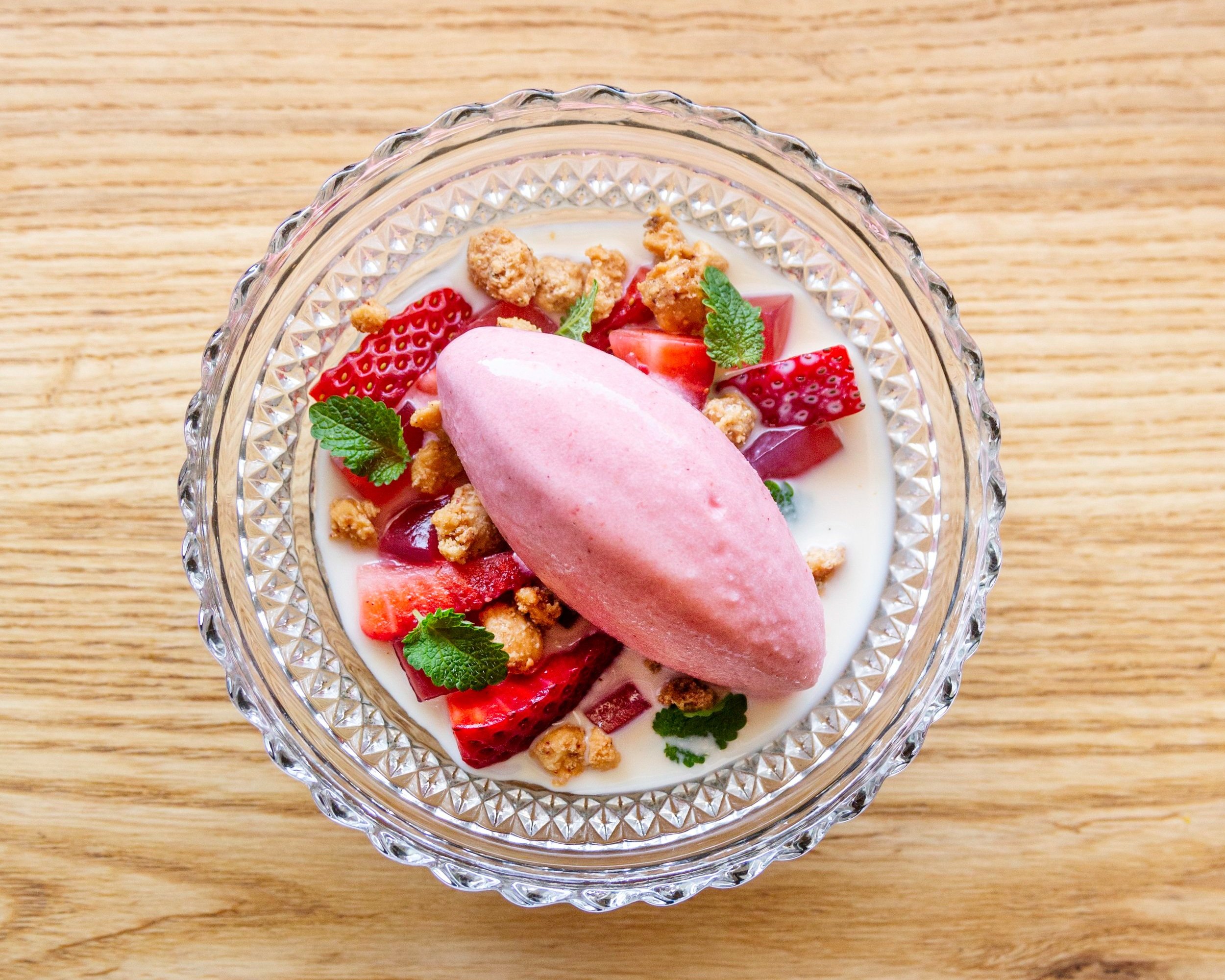The Royal Falooda
Pastry Chef Sarah Cotton uses falooda as a template to showcase seasonality.
Although falooda is a dish with an extensive history, its elements are fairly simple: delicate vermicelli noodles bathed in milk and sweet, rose-flavored syrup, served refreshingly cold. The dish originated in South Asia and traveled east, becoming a staple snack, drink, and dessert from Iran to Myanmar, picking up numerous regional modifications along the way. So when developing a dessert to go alongside Chef Sophina Uong’s savory menu of global flavors at Mister Mao, Pastry Chef Sarah Cotton created her own version of falooda. She went “royal”—a more texturally-driven variation of falooda with the addition of fruit and crunchy nuts.
PHOTOS: Rae serra
Like parfait, faloodas are often served in a tall glass to display the layered ingredients. But Cotton’s presentation is designed to be eaten family-style—she sets all elements in a bowl and tops them with a quenelle of sherbet, with the sweet milk poured over the top tableside. The dessert became a menu staple, acting as a vehicle to feature the best seasonal Louisiana produce. But no matter the time of year, the dessert always hits on those same core components. And last spring’s version, which highlighted blood orange and strawberry, was no different (full recipe here).
PHOTO: Rae serra
Seeds
Basil seeds are hydrated in a syrup made with leftover candied blood orange. Though, Cotton notes, “the candying syrup is essentially a byproduct. Any sweetened liquid will work fine!” The seeds take on the sweet and tart flavor of the syrup while becoming soft and swollen with a texture similar to fish roe or chia seeds.
Noodles
Rice vermicelli are layered over the basil seeds to continue building the soft and slightly chewy texture. “With the noodles, we try to have variation in length which makes it more fun [to eat].” After tearing the noodles, she boils them until they’re fully cooked—they’ll firm up and become “nice and bouncy” by absorbing the syrup and milk.
Rose
Rose is arguably the most dominant flavor in falooda, traditionally incorporated by pouring rose water over the entire dish. But in Cotton’s version, rosewater comes in the form of bite-sized jellies. She soaks rose petals and lemon juice in water, then carefully sets it with agar agar to impart a gentle floral flavor and a playful mouthfeel.
Fruit & Nuts
For Cotton’s spring falooda, fresh Louisiana strawberries take center plate. She macerates the strawberries in sugar, muddles them with rose petals, then soaks the whole mix in boiling-hot water. It gets strained into a sweet, aromatic syrup that soaks the vermicelli. Cotton also tops the rose jellies with a layer of fresh strawberries. Juicy and acidic, the chopped strawberries sit beneath peppercorn-seasoned candied almonds, giving each bite a savory crunch.
Dairy
“For rich, creamy texture,” says Cotton, “we shoot for Dana Cree’s California-style sherbet with lower dairy but lots of pectin to stabilize and get a creamier texture.” Blood orange zest and pink peppercorns are steeped in a base of milk, cream, and sugar, then strained and combined with fresh blood orange juice and strawberry purée. She tops the falooda with a scoop of the tangy sherbet, then it gets brought to the table, where the dessert is drenched in a fragrant vanilla-rose milk. “Like sweet cereal with noodles or boba tea meets milkshake,” she says. “We want to open people’s minds to what dessert can be.”








